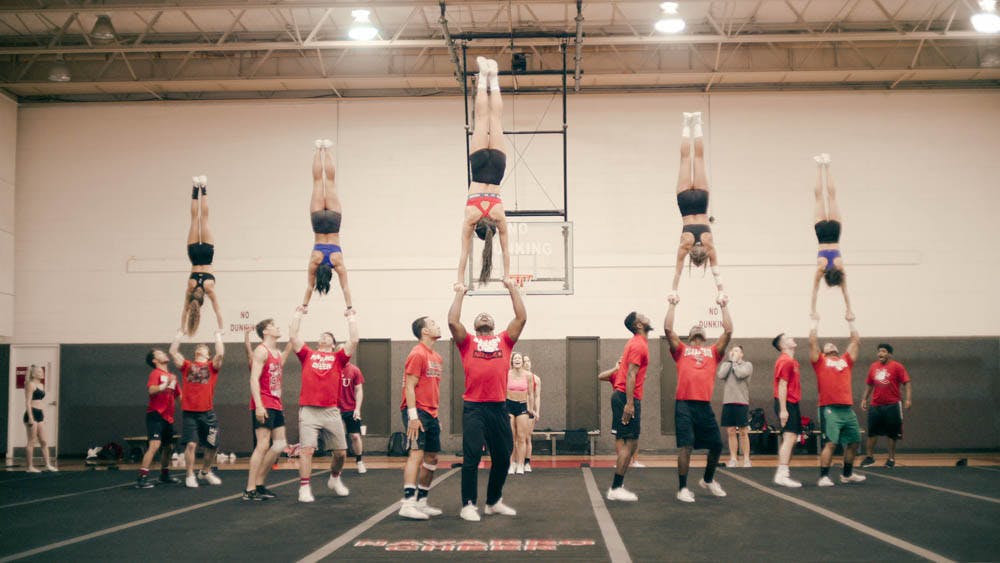“Five, six, seven, eight, one!” That’s the cue for Navarro cheerleader Morgan Simianer to hurl herself thirty feet into the air, flip twice at the top, then land back in the arms of four of her teammates. She groans upon impact but hops out of the stunt nonchalantly, clearly used to the pain.
“There’s a lot of stereotypes that go on with cheerleading. People think that we’re dumb blondes … (or) that we just do cheers like ‘Go team!’... But we actually put our bodies through a lot of pain,” Simianer tells us in a voiceover.
This is the opening scene of “Cheer,” the six-part Netflix docuseries following the 14-time national champion cheerleading team of Navarro College, located in small-town Corsicana, Texas. Released on Jan. 8, the series was directed by Greg Whiteley, also known for the docuseries “Last Chance U.”
“Cheer” spotlights the highs and lows of the sport by underscoring the deep significance it holds to all who practice it. It does so by zooming in on the backstories of five athletes on the team — Morgan Simianer, Lexi Brumback, Gabi Butler, LaDarius Marshall and Jerry Harris — and their poised, tough-as-nails coach Monica Aldama, the “queen” responsible for transforming the college’s cheer program into the title-winning machine it has become over the past two decades. Over the course of the docuseries, the audience grows to love these individuals as Whitely’s attention to the intricacies of their unique relationship with cheerleading — and each other — captures viewers’ attention.
The series begins 65 days out from the National Cheerleaders Association National Championships held annually in Daytona Beach, Florida. This competition is the only chance that collegiate cheer teams get to win a national title every year. Because the stakes are so high, only half of the 40 Navarro cheerleaders will “make mat,” which is Aldama’s slang for making the cut to compete on the big day.
From the beginning, Butler, Brumback and Marshall are portrayed as front-runners for the top 20. Butler, a flyer and tumbler, is a “cheer-lebrity” (cheerleading slang for a household name within the sport) with a reputation that precedes her. Yet, despite her slew of world champion titles and her large social media following, a closer look reveals the pressure she lives under to satiate her family’s escalating expectations to expand her brand. On the other hand, Brumback, the team’s tumbling “beast,” is a high school drop-out who attributes cheerleading to be the sole reason she’s not “sitting in a jail cell right now.” Throughout the episodes, she struggles with separating from her rebellious past and fully embracing her present identity as a cheerleader. Finally, Marshall, a survivor of sexual abuse and bullying, struggles to let and keep his walls down while protecting his spot as the team’s bombastic, vibrant and confident center performer.
Conversely, Simianer and Harris start out among the underdogs of the squad. Simianer enters as an alternate flyer with lacking technique and insecure performance in the air. Coming from a broken family where both of her parents left her when she was a child, Simianer takes the camera crew and the viewer along her journey of making cheer her outlet to fight her way to the top (of the pyramid). Harris makes an impression as a crowd favorite from the beginning. Although he is not as agile or strong as some of his competitors, Harris showcases his endearing personality, unparalleled work ethic and unforgettable “mat talk” — cheer slang for shouting encouragement to others while performing on the floor. Despite recently losing his mother to cancer, his traits and strengths keep him close to hearts of Aldama, his teammates and the Netflix audience.
Together, these diverse experiences and backgrounds culminate to demonstrate how unifying and powerful this sport is. Cheerleading breeds devotion and tenacity in its participants — they will literally bend over backward despite no promise of a career in cheer after graduation, as a professional league for cheerleading does not exist.
The docuseries delves into many discussions about the underlying social problems embedded within the Navarro cheerleading experience. However, many of them are left half-formed and underdeveloped. It touches on the industry’s breeding of body dysmorphia through the weighing of flyers, the ideological conflict between the conservative Texas landscape and the LGBTQ+ identities of many of the team members and the over-dominant monopoly of Varsity Brands on the cheerleading industry, but “Cheer” rarely pushes past a few vague statements, only raising the subjects instead of offering a deep critique.
“Cheer” accomplished a milestone for cheerleading by giving it the exposure and visibility it needed to prove its value as a difficult feat. By the end of the six episodes, it is no longer a question of whether cheerleading is a sport, but rather a question of how far its players will go in order to play it. Because of the enormous, intrinsic danger of the three-tier pyramids, intricate tumbling sequences and complex stunts, even if athletes are competent enough to make mat, they are never safe from sudden injury and subsequent replacement.
From bodies hitting the ground at full speed to members refusing to get their injuries checked in order to continue competing, viewers feel out of breath, full of adrenaline and anxiety, as if they were the very athletes pushing through the bloody, sweaty and teary two minutes and 15 seconds on the floor.





